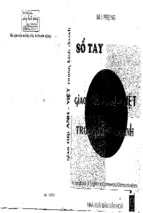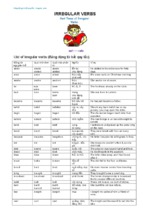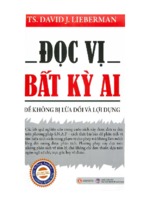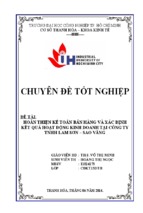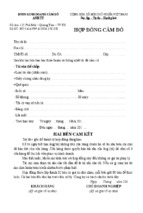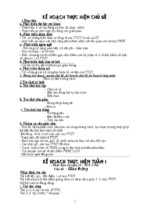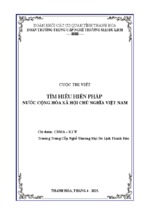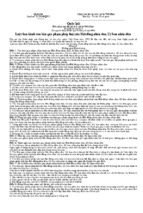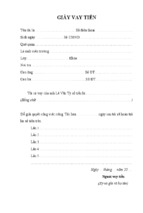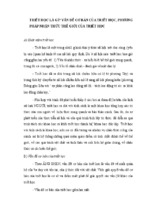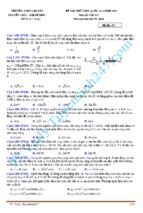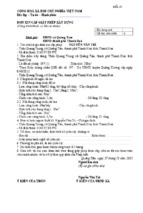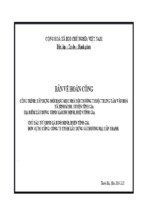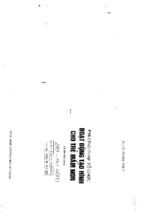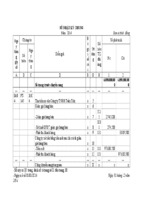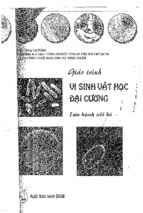lOMoARcPSD|17838488
TRƯỜNG ĐẠI HỌC KINH TẾ QUỐC DÂN
VIỆN THƯƠNG MẠI VÀ KINH TẾ QUỐC TẾ
BỘ MÔN KINH TẾ QUỐC TẾ
===000===
Topic: Exports of Germany in the period 2015 to 2022 and suggestions for
Vietnam
Sinh viên thực hiện
:
Nguyễn Công Dũng
Mã sinh viên
:
11211495
Lớp
:
Kinh tế quốc tế CLC 63A
Khóa
:
63
Hà Nội – 9/2022
1
Downloaded by hây hay (
[email protected])
lOMoARcPSD|17838488
Table of contents
A.
Introduction........................................................................................................................................2
B.
Main content.......................................................................................................................................4
1.
2.
3.
Overview of Germany's economic development, trade and investment.....................................4
1.1.
Economy..................................................................................................................................4
1.2.
Trade........................................................................................................................................7
1.3.
Investment...............................................................................................................................8
Germany’s export...........................................................................................................................9
2.1.
List of embargoed countries...................................................................................................9
2.2.
Overview of Germany's export in the period 2015 to 2022................................................12
2.3.
Types of German export products.......................................................................................14
2.4.
Trade regulations in Germany.............................................................................................14
2.5.
German export process........................................................................................................15
Suggested to Vietnam from export of German.............................................................................16
3.1.
Characteristics of Vietnam's commodity market...................................................................16
3.2.
Current status of Germany’s goods exports..........................................................................17
3.3.
Vietnam's key export industrial products..............................................................................18
3.4.
Export application of the German economy in Vietnam.......................................................19
C.
Conclusion..........................................................................................................................................21
D.
References.........................................................................................................................................22
2
Downloaded by hây hay (
[email protected])
lOMoARcPSD|17838488
A.Introduction
Exports of goods and services represent an important part of a country's
income. Their share in real gross domestic product (GDP) varies with the size and
openness of countries. Beyond their mere quantitative importance, aggregate
exports provide an indication of how well a country is progressing towards
integration into the world economy. Indeed, in the " process of converting separate
national economies into an integrated world economy " called globalization that
took off nearly two decades ago, international trade in goods and services is one
channel through which this integration has been achieved.
According to the Department of Trade Promotion (Ministry of Industry and
Trade), the Federal Republic of Germany is known as one of the most "fastidious"
consumer markets in the world. German consumers are often very picky,
“conservative” and loyal to familiar brands.
An estimated 60% of German
consumers are willing to buy the same brand repeatedly (Santandertrade, 2021).
Therefore, Germans often prefer to use European Union (EU) products, national
and local products. However, in recent times, German consumers have also become
more open to international goods.
For agricultural products, although accounting for a small proportion of total
import turnover, Germany is still the EU country that imports the most fresh and
processed vegetables and fruits (US$23.1 billion), tea and coffee. coffee - spice.
Flavors ($4 billion) processed seafood ($1.65 billion), honey ($274 million...
(according to Trademap ITC data in 2020).
3
Downloaded by hây hay (
[email protected])
lOMoARcPSD|17838488
Germany is the EU's largest economy and the fourth largest in the world. For
many years, Germany remained the third largest importer and exporter of goods in
the world (after the US and China). According to ITC Trademap statistics, in 2020,
Germany's total import-export turnover is 2.550 billion USD (accounting for about
67% of Germany's GDP), of which exports reach 1.378 billion USD and imports
reach 1.172 billion USD.
The core content of this essay lies in analyzing the export activities of Germany
in the period from 2015 to 2022, thereby summarizing and giving ways to develop
Vietnam's exports.
4
Downloaded by hây hay (
[email protected])
lOMoARcPSD|17838488
B. Main content
1. Overview of Germany's economic development, trade and investment
1.1.
Economy
1.1.1.
Overview of economic development
German economy - the fifth largest economy in the world in terms of GDP
(PPP) and the largest in Europe - Germany is a leading exporter of machinery,
vehicles, chemicals and equipment family and benefit from a skilled workforce.
Like its Western European neighbors, Germany faces significant demographic
challenges to sustain long-term sustainable growth. Low birth rates and falling
immigration are increasing pressure on the country's social welfare system and
necessitating structural reforms. Reforms by German Chancellor Gerhard
SCHROEDER (1998-2005) were needed to address high annual unemployment
and low average growth, contributing to strong growth and falling unemployment.
These advances, as well as government subsidies and reductions in working hours,
help explain the relatively low rise in unemployment during the 2008-2009
recession - the deepest recession since World War II and down 5.3% in 2014.
The German government introduced a minimum wage of around $11.60 an
hour, effective from 2015. Efforts to encourage and stabilize started in 2008 and
2009 and tax cuts were introduced in Chancellor Angela Merkel's second term
increased the total Germany's budget deficit – including federal, state and
government budgets – rose to 4.1 per cent in 2010, however spending cuts and
5
Downloaded by hây hay (
[email protected])
lOMoARcPSD|17838488
higher tax collection reduced the deficit to 0.8 per cent in from 2011, to 2012
Germany achieved a budget surplus of 0.1%.
Balanced Budget 2014. A constitutional amendment in 2009 aimed to limit the
government deficit to no more than 0.35% of GDP per year until 2016 although this
target was achieved in 2012. After the disaster The explosion of a nuclear reactor in
Fukushima-Japan in March 2011, German Chancellor Angela Merkel announced in
May 2011, eight of the country's 17 nuclear reactors would have to be shut down
immediately. and the remaining plants will close in 2022. Germany hopes to
replace nuclear power with renewables, which account for about 34% of total
energy consumption, up from 9% in 2000. With the closure of eight plants,
Germany was dependent on nuclear energy, which accounted for 23% of electricity
supply and 46% of electricity generation.
1.1.2.
Germany's key economic sectors
Germany is one of the leading industrialized countries in the world, ranked 4th
in the world after the US, China and Japan in GDP, ranked second in the world in
terms of exports (in 2012 exports 1381 billion euros, +4, 5%). The main industries
are car manufacturing, machinery and equipment manufacturing, chemical industry,
electrical and electronic engineering industry. Since 1975 Germany has been a
member of the G8.
6
Downloaded by hây hay (
[email protected])
lOMoARcPSD|17838488
Source: Share of economic sectors in gross domestic product (GDP) in 2021
Industry: The main industries are automobile manufacturing, machinery and
equipment manufacturing, chemical industry, electrical and electronic engineering
industry.
Agriculture: Most of Germany's area is used for agriculture, but only 2-3% of
the German population works in this industry. The North Coast region specializes
in dairy cows and horses. The foothills of the Alps focus on raising poultry, pigs,
cows and sheep. The fertile strip of land along the southern slopes of the lowlands
is where wheat, barley, cereals, sugar beets, fruit trees, potatoes, and grapes are
grown. Germany is among the world's largest producers of milk, dairy products,
and meat. Agriculture in Germany is regulated by EU agricultural policy.
Services: Thrives in recent years and now contributes the most to GDP.
Frankfurt is Germany's largest financial center and one of the world's leading
financial centers
7
Downloaded by hây hay (
[email protected])
lOMoARcPSD|17838488
1.2.
Trade
Exports are very important in the German economy, employing about 25% of
the workforce. Germany is the second largest exporter in the world (after China)
with a value of over 1000 billion euros in 2013 and is also the third largest import
market in the world (after the US and China) with a about 930 billion USD.
Manufacturing and technology products account for 60% of exports, including
machinery, electronics, automobiles, chemical products, food, textiles, optical and
electrical instruments. The main imported goods are machinery, means of transport,
and chemicals. Germany's most important trading partners are the EU, the US, and
China. The EU market accounts for nearly 60% of exports. German exports outside
the EU, especially to emerging markets such as China and India, tend to increase
rapidly.
Foreign trade is one of the key factors in the success of the German economy.
Exports play a vital role in the German economy and are one of the largest foreign
exchange earners. Germany's main exports include machinery, electronics,
automobiles, chemical products, food, textiles, optical and electrical instruments.
As a country heavily dependent on foreign trade, Germany also imports many
goods and is the second largest importer in the world. Major imports are machinery,
vehicles, chemicals, tobacco, food, beverages, metals and petroleum products.
1.3.
Investment
Germany has an attractive investment environment thanks to its possession of
many technologies, know-how, a geopolitical position in the heart of Europe, highquality infrastructure, mature legislation, and high-quality human resources. Due to
rising labor costs, Germany has the advantage of attracting investment in industries
that use technology and capital, and gradually loses its advantage in industries that
8
Downloaded by hây hay (
[email protected])
lOMoARcPSD|17838488
use labor. Corporate tax reforms at par with the world average provide a certain
advantage for reducing investment costs in Germany, helping Germany to remain
attractive for investment.
Germany is also a big investor holding a lot of source technology. Every year,
Germany invests abroad about 30-45 billion euros, mainly focusing on EU
countries and China.
Since 1998, Germany has started to focus on providing ODA to a few key
countries. Germany's ODA recipients include about 70 countries, divided into two
categories: focus countries and development partner countries. Germany's annual
ODA budget is around 3-4 billion Euros for various sectors. Currently, German
development aid accounts for 0.28% of GDP. Germany has committed to spend
0.33% of GDP on development aid and is striving to achieve the year target of
0.7% of GDP by 2015 on development aid in line with the target set by the United
Nations.
2. Germany’s export
2.1.
List of embargoed countries
For foreign policy or security policy reasons, restrictions, some of which are
considerable, have been placed on certain countries, which curb trade with the
country concerned. Whether exports may be made from Germany therefore also
depends on the destination of an export shipment.
Basically, there are three categories of embargo measures:
Arms embargo - prohibits the export of armaments to the country concerned,
usually based on Section 74 of the German Foreign Trade and Payments Ordinance
9
Downloaded by hây hay (
[email protected])
lOMoARcPSD|17838488
Partial embargo - specific prohibitions and limitations of trade with the
country concerned, as laid down by European Union regulations
Total embargo - all trade is prohibited, as laid down in European Union
regulations
Depending on the objective of the specific trade restriction, the type and extent
of the embargo rules include various restrictions and prohibitions which
supplement or strengthen other restrictions laid down elsewhere, and which are not
limited to the country of destination.
Usually within the framework of the country-specific embargo measures
additional prohibitions or authorisation requirements for the export of products to
the country concerned are introduced, as well as a variety of other restrictions
which confine foreign trade to a greater or a lesser extent.
There is a prohibition on the provision of funds and economic resources to
specific individuals, organisations and institutions.
The procedures that are indirectly related to an exportation, such as payments,
agency services or technical assistance may also be restricted on the basis of
embargo measures.
The following link leads to a list of all the embargoed countries and a summary
of the embargo restrictions that must be directly observed when products are
exported.
The following list of sanctions imposed on the respective countries is an
abbreviated and incomprehensive list for reference purposes only. Legally binding
are solely the legal texts printed in the Official Journal of the European Union
10
Downloaded by hây hay (
[email protected])
lOMoARcPSD|17838488
(formerly the Official Journal of the European Communities) and/or the German
Federal Gazette (Bundesanzeiger), as amended.
Armenia
Azerbaijan
Belarus (White Russia)
Bosnia
Burundi
China
Democratic Republic of the Congo
Democratic People’s Republic of Korea (North Korea)
Haiti
Iraq
Iran
Republic of Yemen
Lebanon
Libya
Mali
Myanmar (previously Burma)
11
Downloaded by hây hay (
[email protected])
lOMoARcPSD|17838488
Nicaragua
Republic of Guinea
Republic of Guinea-Bissau
Russia
Zimbabwe
Somalia
Sudan
South Sudan
Syria
Pridnestrovian Moldavian Republic
Tunisia
Turkey
Ukraine
Venezuela
Central African Republic
In addition to the embargo measures that apply to specific countries, several
non-country-specific restrictive embargo measures (for example, anti-terrorism
regulation, anti-torture regulation) as well as the prohibitions and restrictions of
12
Downloaded by hây hay (
[email protected])
lOMoARcPSD|17838488
foreign trade under the EC Dual-Use Regulation, the Foreign Trade and Payments
Act, and the Foreign Trade Ordinance that must be observed.
2.2.
Overview of Germany's export in the period 2015 to 2022
Source: The world bank data
The line graph indicated the volatility of the amount of Germany's export in the
period 2015 to 2022. The first thing to note is that Germany's export altered
dramastically in 7 years of research. The diagram shown the amount of export in
2015 was 1575 billion US dollars corresponding to 46.92% gdp of germany that
year. The diagram shown the amount of export in 2016 was 1598 billion US dollars
corresponding to 46.07% gdp of germany that year. The diagram shown the amount
of export in 2017 was 1740 billion US dollars corresponding to 47.17% gdp of
germany that year. The diagram shown the amount of export in 2018 was 1881
billion US dollars corresponding to 47.30% gdp of germany that year,
13
Downloaded by hây hay (
[email protected])
lOMoARcPSD|17838488
increase from 2017. The diagram shown the amount of export in 2019 was 1812
billion US dollars corresponding to 46.62% gdp of germany that year, 3.64%
decline from 2018. The diagram shown the amount of export in 2020 was 1669
billion US dollars corresponding to 43.42% gdp of germany that year, 7.88%
decline from 2019 duo to the effection of covid-19 pandemic. The diagram shown
the amount of export in 2021 was 2004 billion US dollars corresponding to 47.46%
gdp of germany that year, up to 20.02% increase from 2020.
2.3.
Types of German export products
Source: Destatis statisticches Bundesamt
Germany is a top exporter for vehicles and cars parts, machinery,
pharmaceuticals, industrial oils and alcohols. The first place in Germany’s
exports is occupied by cars that represent 11% of Germany’s total exports, followed
by vehicle spare parts with 4% of the exports. The third place is occupied by
pharmaceuticals and aircraft spare parts with a percentage of almost 4. Among
other products that Germany exports there are also petroleum, industrial machinery,
14
Downloaded by hây hay (
[email protected])
lOMoARcPSD|17838488
computers, and medical devices. The countries Germany exports most to are France
and the United States that import about 8% of Germany’s products, followed by
China and the United Kingdom with almost 6%, The Netherlands, Italy, Austria and
Belgium with almost 5% and countries like Russia, Spain, Japan and Turkey
where Germany exports just a small percentage of its goods.
2.4.
Trade regulations in Germany
When it comes to taxes, Germany’s taxation system applies import turnover tax
(Einfuhrumsatzsteuer) of 19% form countries outside the European Union, and 7%
tax for certain categories of products. However, this tax can be deducted as an input
tax (Vorsteuer). EORI registration in Germany is needed for companies engaged in
trade activities.
According to EU regulations there is a Tariff of the Community, also known as
TARIC (Tarif Intégré de la Communauté) that enables rules for goods
imported from
other
EU
member
states,
or goods
exported outside
the
Community. Germany has a list of import (Einfuhrliste) with rules for some
categories of products that require licenses or restrictions are applied. The tariffs
and licenses for these products can be verified online. German VAT registration is
required, according to the current threshold.
Import and export companies interested in IP rights can start the process
for trademark registration in Germany once they are incorporated.
2.5.
German export process
15
Downloaded by hây hay (
[email protected])
lOMoARcPSD|17838488
Source: Exporting guide for Germany
A German federal agency known as the Federal Office for Economic Affairs
and Export Control (Bundesamt für Wirtschaft und Ausfuhrkontrolle, short BAFA)
is approved to make the ultimate decision on whether German products are allowed
for export. The Federal Office for Economic Affairs and Export Control decides on
granting or rejecting an authorisation subsequent to consideration all the accessible
information about the intended use. In various cases the Federal Office for
Economic Affairs and Export Control takes such a choice only after political
consultations with the Federal Ministry of Economics and Energy and the Federal
Foreign Office.
Germany is a member state in European Union. So, the member states do have
some similarities in trade procedures. Since Germany falls under EU countries, a
common trade policy is adopted to import most of the products. A separate rules
and regulations are applied to specific products when importing and exporting in
the European Union called Integrated Tariff of the European Communities (TARIC
code). An EORI number is compulsory for any import, export or transit in EU
16
Downloaded by hây hay (
[email protected])
lOMoARcPSD|17838488
countries. EORI means Economic Operator Registration and Identification. The
European Union (EU) legislation has required all member states to adopt the
Economic Operators Registration and Identification (EORI) scheme. All importers,
exporters and other transporters need to use a unique EORI reference number in all
electronic communications with Customs and other government agencies involved
in the international trade. This means that anyone involved with export, transit or
import operations need to have EORI number.
3. Suggested to Vietnam from export of German
3.1.
Characteristics of Vietnam's commodity market
Market size Vietnam is a developing country with a high economic growth rate
in the region and in the world. According to the General Statistics Office of
Vietnam, Vietnam's average GDP growth in the period 2011-2020 was 5.96%. In
2020, although the economy was negatively affected by the COVID-19 epidemic,
Vietnam's GDP still grew by 2.91%, reached USD 271.2 billion while many
countries in the world had negative GDP growth. This figure shows that Vietnam
has succeeded in controlling the pandemic and minimizing negative impacts on the
economy. Vietnam is in the process of transforming its economy from backward
agriculture to modern industry. At the same time, Vietnam is also an exportoriented economy, with exports playing an increasingly important role in gross
domestic product. Therefore, the demand for modern machinery, equipment and
raw materials for production, export and construction has increased. With a total
population of nearly 100 million people and the average GDP per capita of about
USD 2,786/person in 2020 (World Bank, 2021), Vietnam is becoming a large and
potential consumer market for foreign consumer goods. As a country with a young
population (about 55.5% of the population under the age of 35), Vietnam has
diverse consumption needs and Vietnamese consumers have quickly grasped new
17
Downloaded by hây hay (
[email protected])
lOMoARcPSD|17838488
and modern consumption trends. Vietnam's middle class is forming with about 13%
of the current population and is expected to increase to about a third of the
population by 2026 (World Bank, 2021). This class has modern shopping habits
and high demand for quality products.
3.2.
Current status of Germany’s goods exports
Germany is known as one of the world's leading developed economies with
extremely vibrant trade activities. According to the World Bank, in 2020,
Germany's trade accounted for 81.1% of this country's GDP, of which exports of
goods and services accounted for 43.4% of GDP. For many years, Germany has
always maintained the 3rd largest export country in the world (after China and the
US). In 2020, despite being heavily affected by the COVID-19 pandemic,
Germany's exports still reached USD 1,377.9 billion, accounted for 8% of total
exports worldwide. The German economy is mainly concentrated in manufacturing
and service sectors. German industry is highly specialized, with modern and high
technology that can develop and manufacture many sophisticated and complex
products, especially new technological equipment. Germany's strong industrial
sectors include the manufacturing of aircraft, spacecraft, automobiles, mechanical
machinery, electronic equipment, chemicals, and pharmaceuticals. These are also
products that Germany exports a lot to the world (Table 12). Most of the products
exported from Germany are considered to be of good quality, diverse in models and
types... In particular, German automobiles are very popular with consumers around
the world (including Vietnam). German automobiles now account for nearly 19%
of the world's total automobile exports (World's Top Exports).
3.3.
Vietnam's key export industrial products
In the 2016-2020 period, in general, the export of machinery, equipment, tools
and other spare parts to most markets has increased, with the main markets being:
18
Downloaded by hây hay (
[email protected])
lOMoARcPSD|17838488
the US, EU, Japan, Korea, China. China, India, and Hong Kong account for about
65% of the country's total export turnover of this item.
Among the big markets mentioned above, the proportion of export turnover of
machinery, equipment, tools and spare parts to the US market tends to increase; EU
and Korean markets are relatively stable; while the proportion of export turnover to
Japan, China, India and Hong Kong markets tend to decrease.
According to the results of the report "Assessment of Vietnam's export
potential", the largest export potential belongs to the following categories: cashew
nuts, petroleum, furniture, coal, footwear... Next are handicraft products, seafood,
rubber, shipbuilding, glass, coffee, agricultural machinery, pepper, household
appliances, toys and garments.
3.4.
Export application of the German economy in Vietnam
We all know that Germany also has a very developed agriculture sector. More
than 80% of the country's territory is used for agricultural and forestry purposes.
The value of German agricultural and food exports amounted to EUR 50 billion in
2019 (german-meat.org, 2019), with key export products including chocolate,
cheese, pork, confectionery and some other processed foods. Taking advantage of
that, Germany has become a country with a highly dependent economy and
agricultural exports.
The retail market’s key characteristics are consolidation, market saturation,
strong competition and low prices. Germany is an attractive and cost-efficient
location in the center of the EU. While many consumers are very price sensitive,
the market also provides many wealthy consumers who follow value-for-money
concepts. These consumers are looking for premium quality products and are
willing to pay higher prices. Germany still has some of the lowest food prices in
19
Downloaded by hây hay (
[email protected])
lOMoARcPSD|17838488
Europe, and German citizens spend only about 14 percent of their income on food
and beverages. Low food prices are a result of high competition between
discounters and the grocery retail sale segment.
Fish and fishery products enjoy growing popularity in Germany. The German
market offers lucrative opportunities for fish and seafood products. Fish
consumption is growing as consumers associate fishery products with a healthy
diet. The best prospects for U.S. seafood exports are Alaska pollock, salmon, caviar
substitutes, hake, cod, dogfish, shrimps, crabs, cuttlefish and squid, sea urchin,
catfish, lobster, and scallops. By value, the two most important U.S. fishery export
products to Germany are Alaska pollock and salmon.
Looking at the German and Vietnamese economies, we are also making
significant changes in the field of agricultural exports. According to the report of
the Ministry of Agriculture and Rural Development, the total export turnover of
agriculture, forestry and fishery in the first 6 months of 2022 reached US $ 27.88
billion, up 13.9% over the same period in 2021, of which the US , China and Japan
are the most Vietnamese agricultural products market.
Accordingly, the main agricultural group of 11.37 billion USD (up 8.8%), the
main forest product of 9.1 billion USD (up 3%), aquatic products 5.8 billion USD
(up 40.8%), blankets Raising 176 million USD (down 15.9%), input production of
1.42 billion USD (up 64.8%)
Notably, due to the expansion of the export market, there are 9 products, the
product group with high export value and reach over 1 billion USD including
coffee, rubber, cashew, vegetables, rice, pangasius, Shrimp, wood products, inputs
for production.
20
Downloaded by hây hay (
[email protected])



